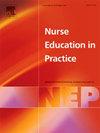Mechanisms of impact of a person-centred care model and simulation-based learning in midwifery education in Central Africa: A qualitative study
IF 3.3
3区 医学
Q1 NURSING
引用次数: 0
Abstract
Aim
To identify the mechanisms having an impact on the implementation of two profiles in a midwifery education programme in the Democratic Republic of Congo (DRC): i) a person-centred care model and ii) strengthened simulation-based learning - both on campus and in clinical practice.
Background
Midwives play a crucial role in advancing maternal and neonatal health. Therefore, it is important for midwifery education programmes to be of high quality.
Design
A qualitative process evaluation with an exploratory design was conducted. Interviews were conducted with 29 midwifery students across four focus groups.
Methods
Data analysis employed deductive and inductive content analysis, guided by an evaluation framework focusing on mechanisms having an impact on the intervention. Registered as ISRCTN10049855.
Results
The implementation of the two profiles created synergistic reinforcement, as simulation-based learning, on campus and in clinical practice, enhanced the implementation of person-centred care through practical case scenarios. Implementing person-centred care was facilitated by increased awareness of women involvement, enhanced communication and skilled faculty, but faced challenges due to cultural norms. Simulation-based learning was supported by adequate material, continuous capacity building and ensuring team safety, though hierarchical barriers in clinical settings limited implementation.
Conclusion
This study identifies the mechanisms impacting the implementation of person-centred care and the strengthened use of simulation-based learning in midwifery education. It highlights that using both profiles in campus-based education and in clinical practice creates synergy and contributes to an enhanced quality of care. The results may offer insights that could be helpful when designing and implementing a midwifery education programme in similar contexts.
中非助产教育中以人为中心的护理模式和模拟学习的影响机制:一项定性研究
目的确定对刚果民主共和国(DRC)助产教育计划中两个概况的实施产生影响的机制:i)以人为本的护理模式和ii)在校园和临床实践中加强基于模拟的学习。助产士在促进孕产妇和新生儿健康方面发挥着至关重要的作用。因此,高质量的助产教育课程非常重要。设计采用探索性设计进行定性工艺评价。对29名助产学学生进行了四个焦点小组的访谈。方法数据分析采用演绎和归纳内容分析,并以评价框架为指导,关注对干预产生影响的机制。注册为ISRCTN10049855。结果在校园和临床实践中,两种模式的实施产生了协同强化效应,即基于模拟的学习,通过实际案例场景加强了以人为本的护理的实施。提高对妇女参与的认识、加强沟通和熟练的教师促进了以人为本的护理的实施,但由于文化规范而面临挑战。基于模拟的学习得到了充足的材料、持续的能力建设和确保团队安全的支持,尽管临床环境中的等级障碍限制了实施。结论:本研究确定了影响以人为本护理实施的机制,以及在助产教育中加强模拟学习的使用。它强调在校园教育和临床实践中使用这两种概况可以产生协同作用,并有助于提高护理质量。研究结果可能为在类似情况下设计和实施助产教育方案提供有用的见解。
本文章由计算机程序翻译,如有差异,请以英文原文为准。
求助全文
约1分钟内获得全文
求助全文
来源期刊

Nurse Education in Practice
NURSING-
CiteScore
5.40
自引率
9.40%
发文量
180
审稿时长
51 days
期刊介绍:
Nurse Education in Practice enables lecturers and practitioners to both share and disseminate evidence that demonstrates the actual practice of education as it is experienced in the realities of their respective work environments. It is supportive of new authors and will be at the forefront in publishing individual and collaborative papers that demonstrate the link between education and practice.
 求助内容:
求助内容: 应助结果提醒方式:
应助结果提醒方式:


